

Cannabinoid.
Endocannabinoid system. The endocannabinoid system has been studied using genetic and pharmacological methods.
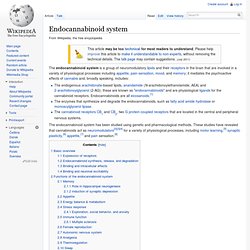
These studies have revealed that cannabinoids act as neuromodulators[2][3][4] for a variety of physiological processes, including motor learning,[5] synaptic plasticity,[6] appetite,[7] and pain sensation.[8] Cannabis (drug) Cannabis is often consumed for its psychoactive and physiological effects, which can include heightened mood or euphoria, relaxation,[10] and an increase in appetite.[11] Unwanted side-effects can sometimes include a decrease in short-term memory, dry mouth, impaired motor skills, reddening of the eyes,[10] and feelings of paranoia or anxiety.[12] Effects Main short-term physical effects of cannabis A 2013 literature review said that exposure to marijuana had biologically-based physical, mental, behavioral and social health consequences and was "associated with diseases of the liver (particularly with co-existing hepatitis C), lungs, heart, and vasculature".[21] The medicinal value of cannabis is disputed.

The American Society of Addiction Medicine dismisses the concept of medical cannabis because the plant fails to meet its standard requirements for approved medicines. Memory. Overview of the forms and functions of memory in the sciences In psychology, memory is the process in which information is encoded, stored, and retrieved.

Encoding allows information that is from the outside world to reach our senses in the forms of chemical and physical stimuli. In this first stage we must change the information so that we may put the memory into the encoding process. Storage is the second memory stage or process. This entails that we maintain information over periods of time. From an information processing perspective there are three main stages in the formation and retrieval of memory: The loss of memory is described as forgetfulness, or as a medical disorder, amnesia. Mood (psychology) A mood is an emotional state.
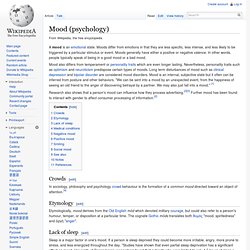
Moods differ from emotions in that they are less specific, less intense, and less likely to be triggered by a particular stimulus or event. Moods generally have either a positive or negative valence. Nociception. Nociception (also nocioception or nociperception) is the encoding and processing in the nervous system of noxious stimuli.[1] It is the afferent activity in the peripheral and central nervous systems produced by stimulation of specialized free nerve endings called "nociceptors" or "pain receptors" that only respond to tissue damage or other intense chemical (e.g., chilli powder in the eyes), mechanical (e.g., pinching, crushing) or thermal (heat and cold) stimulation.[2][3] Once stimulated, a nociceptor sends a signal along a chain of nerve fibers via the spinal cord to the brain.
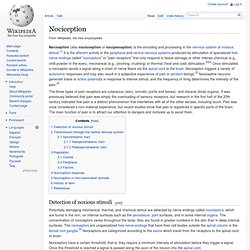
Appetite. Physiological factors[edit] Cannon and Washburn (1912) proposed that eating begins when we have an empty stomach.

They suggested that the walls of an empty stomach rub against each other to produce what are commonly called "hunger pangs". Some skeptics called Cannon's explanation of hunger "the rumble theory". However, observations of surgical patients indicated that there was more to the onset of eating than hunger pangs. Lipid. Lipids are a group of naturally occurring molecules that include fats, waxes, sterols, fat-soluble vitamins (such as vitamins A, D, E, and K), monoglycerides, diglycerides, triglycerides, phospholipids, and others.

The main biological functions of lipids include storing energy, signaling, and acting as structural components of cell membranes.[4][5] Lipids have applications in the cosmetic and food industries as well as in nanotechnology.[6] Although the term lipid is sometimes used as a synonym for fats, fats are a subgroup of lipids called triglycerides. Lipids also encompass molecules such as fatty acids and their derivatives (including tri-, di-, monoglycerides, and phospholipids), as well as other sterol-containing metabolites such as cholesterol.[7] Although humans and other mammals use various biosynthetic pathways to both break down and synthesize lipids, some essential lipids cannot be made this way and must be obtained from the diet.
Receptor (biochemistry) Transmembrane receptor:E=extracellular space; I=intracellular space; P=plasma membrane The structures of receptors are very diverse and can broadly be classified into the following categories: Type 1: L (ionotropic receptors)– These receptors are typically the targets of fast neurotransmitters such as acetylcholine (nicotinic) and GABA and activation of these receptor results in changes in ion movement across the membrane.
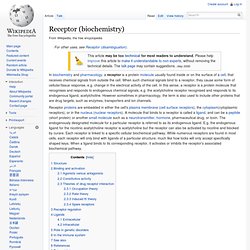
They have a hetero structure. Each subunit consists of the extracellular ligand-binding domain and a transmembrane domain where the transmembrane domain in turn includes four transmembrane alpha helixes. Cannabinoid receptor. Cannabinoid receptor type 1. Structure[edit] The CB1 receptor shares the structure characteristic of all G-protein-coupled receptors, possessing seven transmembrane domains connected by three extracellular and three intracellular loops, an extracellular N-terminal tail, and an intracellular C-terminal tail.[1] These receptors may exist as homodimers or form heterodimers or oligomers when coexpressed with one or more classes of G-protein-coupled receptors.

Observed heterodimers include A2ACB1, A2A, CB1D2, orexin 1/CB1, while many more may only be stable enough to exist in vivo.[2] Recent evidence suggests that these receptors may also possess an allosteric binding site, which may become a target for enhancing the clinical modulatory effects of cannabinoids.[2] Mechanism[edit] Research suggests that the majority of CB1 receptors are coupled through Gi/o proteins. Cannabinoid receptor type 2. G protein-coupled receptor. The seven-transmembrane α-helix structure of a G protein-coupled receptor There are two principal signal transduction pathways involving the G protein-coupled receptors: the cAMP signal pathway and the phosphatidylinositol signal pathway.[6] When a ligand binds to the GPCR it causes a conformational change in the GPCR, which allows it to act as a guanine nucleotide exchange factor (GEF).
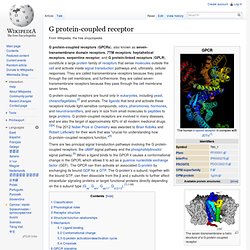
The GPCR can then activate an associated G-protein by exchanging its bound GDP for a GTP. The G-protein's α subunit, together with the bound GTP, can then dissociate from the β and γ subunits to further affect intracellular signaling proteins or target functional proteins directly depending on the α subunit type (Gαs, Gαi/o, Gαq/11, Gα12/13).[7]:1160.